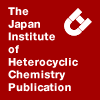

HETEROCYCLES
An International Journal for Reviews and Communications in Heterocyclic ChemistryWeb Edition ISSN: 1881-0942
Published online by The Japan Institute of Heterocyclic Chemistry
Regular Issue
Vol. 71, No. 5, 2007
Published online:
■ Contents
FREE:PDF (739KB)Published online: 13th March, 2007
■ Advances in the Synthesis and Biological Perspectives of Benzannulated Medium Ring Heterocycles
Tirtha Pada Majhi, Basudeb Achari, and Partha Chattopadhyay*
*Department of Chemistry, Indian Institute of Chemical Technology, 4, Raja S.C. Mullick Road, Jadavpur, Kolkata 700032, India
Abstract
Benzannulated medium ring heterocycles represent a class of compounds, capable of binding to multiple receptors with high affinity and act as good antagonist. Exploration of these types of compounds in drug discovery is a rapidly emerging area in synthetic chemistry and exploitation of these molecules will help researchers to discover biologically active compounds with a broad range of medicinal values.
Published online: 20th March, 2007
■ Efficient 2-Amino-2-thiazolin-4-ones or 2-Iminothiazolidin-4-ones Formation from Thioureas and Maleimides under Solvent-Free Conditions
Tetsuro Shimo, Yuki Matsuda, Tetsuo Iwanaga, Teruo Shinmyozu, and Kenichi Somekawa*
*Department of Applied Chemistry, Faculty of Engineering, Kagoshima University, Korimoto 1-21-40, Kagoshima 890-0065, Japan
Abstract
A facile method for the construction of 2-thiazolin-4-one or thiazolidin-4-one structure is described. Condensation reactions of thiourea (1a) and maleimides (2) under solvent-free conditions gave 2-amino-2-thiazolin-4-ones (3) via Michael-type reaction, while similar reactions of N-substituted thioureas (1b-d) with 2 afforded 2-iminothiazolidin-4-ones (4). Since the solvent-free reactions of 1 with 2a afforded 3 in good yields, the synthetic method was found to be effective from the viewpoint of green chemistry.
Published online: 6th March, 2007
■ Synthesis of Lactam Analog of 4-Epi-brefeldin A
Seung-Mann Paek, Seung-Yong Seo, Kyung-Hoon Min, Dong Mok Shin, Young Keun Chung, and Young-Ger Suh*
*The Research Institute of Pharmaceutical Sciences, College of Pharmacy, Seoul National University, Shillim-Dong, San 56-1, Kwanak-Gu, Seoul 151-742, Korea
Abstract
A concise synthetic route to the lactam analog of 4-epi-brefeldin A is described. The key features of the synthesis involve cross metathesis of the bicyclic lactone intermediate and the side chain subunit readily available from an amino acid, and 13-membered macrolactam formation. Unlike the case of synthesis of natural (+)-brefeldin A, the introduction of C4-alcohol into the 13-membered lactam skeleton furnished the opposite configuration, which was confirmed by X-ray crystallographic analysis.
Published online: 9th March, 2007
■ Cassane and Norcassane Diterpenoids of Caesalpinia bonduc
Joy S. Roach, Stewart McLean, William F. Reynolds, and Winston F. Tinto*
*Laboroatory of Bioorganic Chemistry, Department of Biological and Chemical Sciences, University of the West Indies, Cave Hill Campus, P. O. Box 64, Bridgetown, Barbados, BB11000, West Indies
Abstract
Two new cassane and one norcassane diterpenoid (1-3) were isolated from Caesalpinia bonduc along with caesaldekarins C (4) and F (5). During acquisition of NMR spectral data on compound 5, it rearranged to produce compounds 7 and 8, via compound 6. The 1H and 13C NMR spectra of all compounds were completely assigned using a combination of 2D NMR experiments, including 1H-1H COSY, HSQC, HMBC, and T-ROESY sequences. Compounds 4 and 5 showed modest cytotoxic activity.
Published online: 10th April, 2007
■ Dimerization of (+)-Lysergic Acid Esters
István Moldvai,* Eszter Gács-Baitz, Eszter Termesvári-Major, Luca Russo, Imre Pápai, Kari Rissanen, Éva Szárics, Julianna Kardos, and Csaba Szántay
*Department of Natural Organic Compounds, Institute of Bimolecular Chemistry, Chemical Research Center of the Hungarian Academy of Sciences, H-1525 Budapest, POB 17, Hungary
Abstract
Dimer isomer mixtures, characterized by a bridgehead C8-C8’ bond, (6a-7a; 6b-7b) were obtained from (+)-lysergic acid methyl or ethyl ester (1b; 1c) in a solution of methanol or ethanol. The isomers were separated, and their structures were determined by detailed NMR measurements and X-ray analysis. Density functional theory was applied to provide insight into the reaction mechanism. Based on an extended examination and the theoretical calculations, a plausible reaction sequence leading to dimers is also presented. The proposed mechanism has been verified by detecting the formation of the superoxide radical anion (O2·-).
Published online: 6th March, 2007
■ Reaction of Hydrazonoyl Chlorides to Trimethylsilyl Homoallyl Ethers
Paola Del Buttero, Giorgio Molteni,* Sara Mondini, and Alessandro Ponti
*Dipartimento di Chimica Organica e Industriale, Università degli Studi di Milano, Via Golgi 19, 20133 Milano, Italy
Abstract
Title reaction gave mainly 4,5-dihydropyrazole derivatives due to nitrilimine cycloaddition onto the ethylenic bond. Cycloaddition regioselectivity was good despite the electronic demands of the substituents placed to the ethylenic dipolarophile are quite similar. Metalated transition states have been proposed in order to account the observed regioselectivity. Highly substituted cyclopropanes were also formed due to the electrophilic attack of a nitrilium-like carbocation to the ethylenic bond.
Published online: 27th March, 2007
■ Efficient Synthesis of Pyrimidinecarbonitriles and Their Derivatives
Petra Doláková, Milena Masojídková, and Antonín Holy*
*Institute of Organic Chemistry and Biochemistry, Academy of Sciences of the Czech Republic, Flemingovo nam. 2, CZ-16610 Prague 6, Czech Republic
Abstract
New approach to pyrimidinecarbonitriles was developed. Pyrimidine-4- and 6-carbonitriles were prepared by palladium-catalyzed cross-coupling reaction of iodopyrimidines with Zn(CN)2 in very good yields. The cyano group was converted into the corresponding acyl groups by the treatment with Grignard reagents and transformed to amido and imido function as well.
Published online: 27th March, 2007
■ Four Acylated Cyanidin 3-Sambubioside-5-glucosides from the Purple-Violet Flowers of Lobularia maritima
Fumi Tatsuzawa,* Kenjiro Toki, Norio Saito, Koichi Shinoda, Atsushi Shigihara, and Toshio Honda
*Laboratory of Floriculture, Faculty of Floriculture, Minami-Kyushu University, 11609 Takanabe, Koyu-gun, Miyazaki 884-0003, Japan
Abstract
Four acylated cyanidin 3-sambubioside-5-glucosides were isolated from the purple-violet flowers of Lobularia maritima (L.) Desv. ‘Easter Bonnet Violet’ along with six known anthocyanins. These new pigments were determined by chemical and spectroscopic methods to be cyanidin 3-O-[2-O-(2-O-(trans-feruloyl)-β-D-xylopyranosyl)-6-O-(4-O-(β-D-glucopyranosyl)-trans-p-coumaroyl)-β-D-glucopyranoside]-5-O-β-D-glucopyranoside, cyanidin 3-O-[2-O-(β-D-xylopyranosyl)-6-O-(trans-feruloyl)-β-D-glucopyranoside]-5-O-β-D-glucopyranoside, cyanidin 3-O-[2-O-(2-O-(trans-caffeoyl)-β-D-xylopyranosyl)-6-O-(trans-feruloyl)-β-D-glucopyranoside]-5-O-β-D-glucopyranoside or cyanidin 3-O-[2-O-(2-O-(trans-feruloyl)-β-D-xylopyranosyl)-6-O-(trans-caffeoyl)- β-D-glucopyranoside]-5-O-β-D-glucopyranoside, and cyanidin 3-O-[2-O-(2-O-(trans-feruloyl)-β-D-xylopyranosyl)-6-O-(trans-feruloyl)-β-D-glucopyranoside]-5-O-β-D-glucopyranoside.
Published online: 9th March, 2007
■ Efficient Synthesis of (±)-N-Boc-pregabalin via Hetero-Diels-Alder Addition of Methyl 3-Nitrosoacrylate to Ethyl Vinyl Ether
John K. Gallos,* Elli S. Alexandraki, and Christos I. Stathakis
*Department of Chemistry, Aristotle University of Thessaloniki, Thessaloniki 54124, Greece
Abstract
A new synthetic approach towards (±)-N-Boc-pregabalin is reported in this paper, which involves hetero-Diels-Alder addition of 3-nitrosoacrylate to ethyl vinyl ether and subsequent reduction of the C=N double bond of adduct, alteration of the ester functionality and reductive N-O bond scission followed by oxidation of the alcohol thus produced.
Published online: 15th March, 2007
■ Pubescenone, a New Marasmane Sesquiterpenoid from the Mushroom Lactarius pubescens
Hong-Jun Shao, Chun-Jiang Wang, Yun Dai, Fei Wang, Wan-Qiu Yang, and Ji-Kai Liu*
*Kunming Institute of Botany, The Chinese Academy of Sciences, Kunming, Yunnan 650204, China
Abstract
A new marasmane sesquiterpenoid, named pubescenone (1), was isolated from the fruiting bodies of the basidiomycete Lactarius pubescens together with a known sesquiterpene aldehyde, lactaral (2). The structure of pubescenone (1) was elucidated on the basis of extensive spectral methods (MS, IR, 1D and 2D NMR experiments).
Published online: 6th March, 2007
■ Efficient One-Pot Synthesis of 2-Substituted Furans from 3,3-Diethoxypropyne and Aldehydes Using a Ti(O-i-Pr)4/2 i-PrMgCl Reagent
Deok Ki Eom, Seong Jib Choi, and Duk Keun An*
*Department of Chemistry, Kangwon National University, 192-1 Hyoja-2-dong, Chuncheon, Kangwon 200-701, Korea
Abstract
A new, efficient and direct synthetic method for synthesizing 2-substituted furans using titanium-alkyne complex from easily preparable lithium propargyl alcohol derivatives derived from commercially available 3,3-diethoxypropyne, n-butyllithium and aldehydes by a Ti(O-i-Pr)4/ 2 i-PrMgCl reagent in 68-85% yields.
Published online: 27th March, 2007
■ Four New Prenylated 2-Arylbenzofurans from the Root Bark of Artocarpus petelotii
Hong Shen, Ai-Jun Hou,* and Ji-Zong Li
*School of Pharmacy, Fudan University, Yi Xue Yuan Road 138, Shanghai 200032, China
Abstract
Four new prenylated 2-arylbenzofurans, artopetelins H-K (1-4), were isolated from the root bark of Artocarpus petelotii Gagnep. Their structures were elucidated by extensive 1D-, 2D-NMR, and MS spectral analysis.
Published online: 6th March, 2007
■ Semisynthesis and Antifeedant Activity of New Acylated Derivatives of Tutin, a Sesquiterpene Lactone from Coriaria sinica
Meng-Lou Li, Jun Cui, Rui-Hao Qin, Jin-Ming Gao,* Yan-Bing Zhang, Xin-Rong Guo, and Wei Zhang
*College of Sciences, Northwest A&F University, Yangling, Shaanxi, 712100, China
Abstract
Three sesquiterpene lactones, tutin (1), coriatin (2), and corianin (3), were isolated from the achenes of Coriaria sinica Maxim, and corianin (3) being for the first time obtained. Moreover, three new derivatives (1a-c) were prepared by acylation at the 2-position of tutin (1). Structures of these compounds were identified and characterized by spectroscopic and X-ray crystallographic analysis. Tutin and acylated analogs thereof showed antifeedant activity against Mythimna separata, and the most potent was 2-iso-butenoyltutin (1b).
Published online: 27th March, 2007
■ N-Methylpseudoephedrine-Mediated Asymmetric Syntheses of O-Carboxyalkylated Flavones
Kyoung Hee Kang, Ji Hyeon Heo, Yongtae Kim, and Yong Sun Park*
*Department of Chemistry, Konkuk University, 1 Hwayangdong, Seoul 143-701, Korea
Abstract
N-Methylpseudoephedrine-mediated dynamic resolution of α-bromoacetates for stereoselective preparation of O-carboxyalkylated flavone has been developed. Substitutions with hydroxyflavone and Cs2CO3 in MeCN and following ethanolysis provided O-carboxyalkylated flavones 3-10 up to 60% overall yield and 98:2 er. In addition, we have described the regioselective alkylations of chrysin to provide 7-O-carboxyalkylated chrysins 11-13 with high enantioselectivities.
Published online: 27th March, 2007
■ An Improved Synthesis of 3-Methyl-4-nitro-5-heteroarylethenylisoxazoles
Mauro F. A. Adamo,* Eleanor F. Duffy, Vivekananda R. Konda, and Finbar Murphy
*Department of Pharmaceutical and Medicinal Chemistry, Centre for Synthesis and Chemical Biology (CSCB), The Royal College of Surgeons in Ireland, 123 St. Stephen’s Green, Dublin 2, Dublin, Ireland
Abstract
A high yielding synthesis of polyfunctional scaffold 3-methyl-4-nitro-5-heteroarylethenylisoxazole is described. The novel condition allowed the preparation of reactive title compounds in high yield.
Published online: 9th March, 2007
■ Preparation of a 1-Unsubstituted-2,3-Dihydro-1-benzazepine Derivative
Atsuko Nishiguchi,* Tomomi Ikemoto, Tatsuya Ito, Shotaro Miura, and Kiminori Tomimatsu
*Chemical Development Laboratories, Takeda Pharmaceutical Company, Ltd., 17-85 Jusohonmachi 2-chome, Yodogawa-ku, Osaka 532-8686, Japan
Abstract
We developed a three-step method of producing a 1-unsubstituted-2,3-dihydro-1-benzazepine derivative (2) from 11. The alkylation of 9, obtained from 11, and the subsequent intramolecular condensation of 12 in dialkyl carbonate with a metal alcoholate were conducted in one pot to afford 1-benzazepine (13) in good yield. 13 was then hydrolyzed to give 2 in 48% overall yield from 11. Furthermore, we synthesized the orally active CCR5 antagonist intermediate 18 from 2.
Published online: 29th March, 2007
■ New Flavanone Oligoglycosides, Theaflavanosides I, II, III, and IV, with Hepatoprotective Activity from the Seeds of Tea Plant (Camellia sinensis)
Ning Li, Toshio Morikawa, Hisashi Matsuda, Kiyofumi Ninomiya, Xian Li, and Masayuki Yoshikawa*
*Kyoto Pharmaceutical University, Misasagi, Yamashina-ku, Kyoto 607-8412, Japan
Abstract
Four new flavanone oligoglycosides, theaflavanosides I, II, III, and IV, were isolated from the seeds of Camellia sinensis. The structures of theaflavanosides were elucidated on the basis of chemical and physicochemical evidence. Among them, theaflavanoside III was found to show hepatoprotective effect on D-galactosamine-induced cytotoxicity in primary cultured mouse hepatocytes.
Published online: 29th March, 2007
■ Synthesis of a Diastereomeric Mixture of (4R,5S,6E,14R)- and (4R,5S,6E,14S)-Melithiazols G
Hiroyuki Takayama, Keisuke Kato, Masayuki Kimura, and Hiroyuki Akita*
*School of Pharmaceutical Sciences, Toho University, 2-2-1, Miyama, Funabashi, Chiba 274-8510, Japan
Abstract
A Wittig reaction between (+)-3 and the phosphoranylide derived from the bithiazole-type phosphonium iodide [(±)-4] using lithium bis(trimethylsilyl)amide afforded a diastereomeric mixture of the (+)-(4R,5S,6E,14R)- and (4R,5S,6E,14S)-melithiazols G (1), whose NMR spectral data were identical with those of the natural product (1). The antifungal activity of the synthetic diastereomeric mixture of melithiazols G (1) against the phytopathogenic fungus, Phytophthora capsici, was evaluated by using a paper disc assay method.